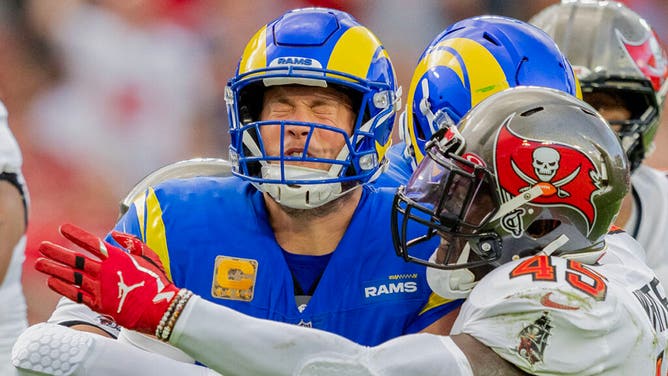NFL Needs Definitive Concussion Test For Players, And The Race Is On
The confounding case of Rams quarterback Matthew Stafford is the latest to underscore the need for a definitive concussion test. The good news on this holiday weekend is that progress is being made.
Stafford missed the Rams’ Week 10 game due to apparent concussion symptoms but without an announced formal diagnosis. After being sacked Sunday in New Orleans, he was put back into concussion protocol, will miss this week’s game in Kansas City, but Coach Sean McVay pointedly said Wednesday that his QB still has not been given a concussion diagnosis.

Rams quarterback Matthew Stafford. (Getty Images)
This uncertainty comes with the Tua Tagovailoa episode still top of mind. In late September against Buffalo, Tua’s head was bounced off the turf. He staggered to his feet, wobbled, then collapsed to his knees.
Based on clinical observation of the video, Dr. Chris Nowinski, co-founder of the Concussion Legacy Foundation (CLF), said he was “99.99% certain” Tua had suffered a concussion. But a subsequent NFL/NFLPA investigation reached a finding of no concussion.
Both opinions are subjective, neither more accurate than the other. The NFL’s four-part concussion exam – checklist of 22 possible symptoms, cognitive/memory test, eye-tracking test, balance test – is “far from perfect,” according to Dr. Robert Cantu, the other co-founder of CLF.
'Holy Grail Of Concussion Diagnosis'
For 20 years, researchers have been pursuing an objective test based on biomarkers. Following a head injury, protein biomarkers are released more readily into the bloodstream. So a simple blood test would allow comparison of post-trauma protein levels to the patient’s baseline.
This, in the words of NFL chief medical officer Dr. Allen Sills, is “the Holy Grail of concussion diagnosis.”
The most advanced research in this space is being done by a consortium of the NCAA and U.S. Department of Defense. Their project is known as CARE (Concussion Assessment, Research and Education).
The CARE team has produced encouraging results among a large pool of subjects. But individual cases within the pool are still showing too many false positives and false negatives. Testing methodology needs to be more sensitive, more specific.
Another driver of research is competition among biotechnology companies. The Quanterix Corporation of Billerica, Mass., has developed, patented and is profiting enormously from a biomarker test for moderate-to-severe injury that causes brain bleeding. Now the race is on for a test applicable to mild brain injury, aka concussion.
In addition to diagnosis, these tests would indicate when protein levels have normalized, thereby green-lighting return to play. At present, NFL medical teams are only guessing that their standard of seven days asymptomatic is sufficient for clearing a player.
'Really Scary. ... We Don't Know'
In Stafford’s case, was he safe to play Sunday in New Orleans two days after emerging from protocol? In Tua’s case, was the Buffalo incident related four days later to his horrific posturing after the violent throw-down sack in Cincinnati?
“This is really scary for those of us making these decisions,” Dr. Cantu told me yesterday. “Imaging shows us abnormalities in the brain as much as a month after trauma. But are those indicators of ongoing injury or the effects of healing that will eventually resolve? We don’t know.”
So research continues. Resources are flowing. The CARE project alone has accumulated more than $100 million in funding. The challenge for scientists is identifying not one biomarker but rather a group of biomarkers that, in combination, will make their test reliable.
Dr. Cantu is convinced they will succeed, and soon. Meanwhile, he describes the status quo as “frustrating, maddening.”